When the offer came for a review copy of a new cookbook about baking with whole grain flours, I could barely contain my excitement long enough to provide a professional-yet-adamantly-affirmative response. We’ve been working on reducing the amount of refined white flour we consume, but it hasn’t been easy. Luckily, we now have Good to the Grain to fall back on.
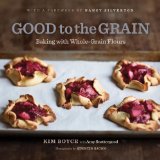


But enough about what the book isn’t. In reading this text, I was left with the impression that Kim Boyce is a woman who brings her considerable pastry experience to bear on the delightful discovery of whole grain baking at home. She’s stumbled upon these ingredients: quinoa flour, oat bran, etc. and figures out how to best incorporate them into baked goods that simultaneously celebrate the flavor of the whole grain and avoid the textural pitfalls that can sometimes occur when following a strict “whole grain only” approach.
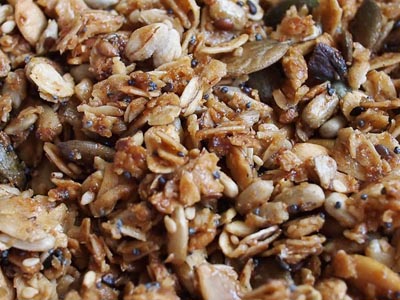
Boyce begins with her background. Yes, she has been a pastry chef at nationally-known restaurants and no doubt has some pretty fancy baking skills in her arsenal. This book, however, is about whole grains in the hands of home cooks. The recipes aren’t fussy, and while she includes fairly detailed technique notes, the concepts are straightforward. It seems this is less “pastry arts” and more baking at home. Even the look of the baked goods is almost defiantly rustic. The photography is elegant and natural, and I think this serves to highlight the lo-fi aesthetic of the scones and bars and pies. In her words, “Who knew that after years of financiers, sabayons, and puff pastry, it would be a pancake that would change the way I baked?”
She follows the technique notes with a section on required (or simply nice-to-have) tools, all of which are reasonable and most of which are inexpensive. Following this is a short ingredient section. The reader may be surprised to find that flour is touched on only briefly here, but flip a few more pages and it’ll make sense. The recipe sections that follow are divvied up by flour-type, and the lead-in to each chapter provides an in-depth description of the flour in question: whole-wheat, amaranth, buckwheat, corn, kamut, multigrain, oat, quinoa, rye, spelt, teff. She rounds these out with a section on jams and compotes and follows this with a listing of ingredient sources and a helpful conversion chart.
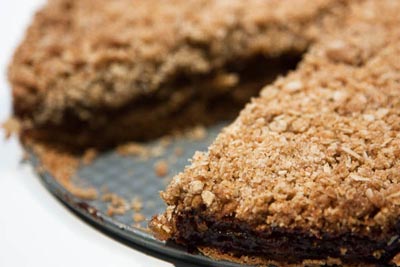
I have now tried several of the recipes and have yet to run into one that I didn’t like. My first attempt was rich, buttery Crumble Bars. These were excellent for using up the rest of the pear butter that I had canned so long ago. Essentially, a shortbread crust is made from, among other things, rye flour and all-purpose flour. This is filled with the jam or fruit butter of choice. And finally, the whole thing is topped with a rolled oat, rye flour, and all-purpose flour crumble and baked till set.
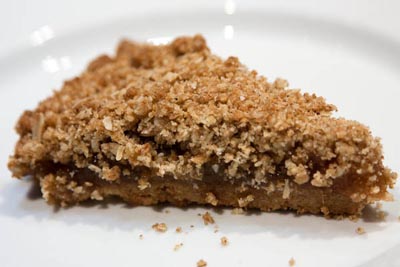
These were a bit messy to eat, and mine at least were not beautiful, but the flavor was outstanding. The buttery shortbread crust was the perfect counter to the intensified pear butter. The topping provided a nice crunch and an extra dose of whole grains with the oats. Were I to make this again, I would try to put a parchment sleeve around the inside of the spring-form pan. The caramelized pear butter was a bear to clean.
Next, I tried Boyce’s Blue Cheese and Onion Scones. I learned a couple things with this recipe. First, I love love love onion jam. It is nothing more and nothing less than onions slowly cooked in a bit of oil and seasoned with salt, pepper, and a splash of red wine vinegar. In searching for sweet onions at the grocery store, I happened on Peruvian Sweets, and these seemed to work beautifully.
The second thing I learned was that there’s a creature called graham flour, and it is wonderful. It’s just a more coarsely ground whole wheat flour, and I almost didn’t purchase it since I already had “regular” whole wheat flour in the pantry. I’m glad I did though. At least while the scones were fresh, the graham flour provided a very pleasant crunch to the otherwise soft scones. The sweet onion jam and the salty, sometimes blissfully browned blue cheese provided almost jarring bursts of flavor in the mildly sweet pastry. We ate these so quickly that I never managed to get a photo of them.
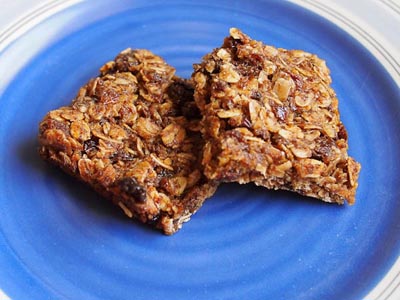
The next two things I tried didn’t have whole grain flour, but instead relied on the grains themselves. First up were Granola Bars. These made excellent use of rolled oats which were augmented in flavor and nutrition by flaxseed meal, raisins, and of course lovely things like honey, molasses, and brown sugar. I really enjoyed the flavor of these, but I failed a bit in the execution. I managed to overcook the sugar syrup and the bars were a bit harder than they should have been. That said, it didn’t stop me from finishing them.
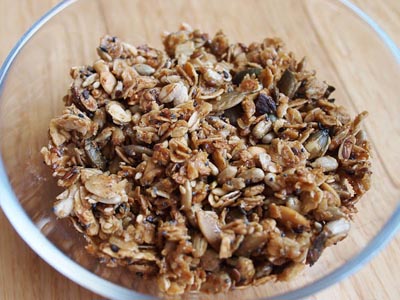
My new favorite snack is Boyce’s Seeded Granola. I absolutely cannot stop eating it. The dry mix is a combination of pumpkin seeds, rolled oats, sunflower seeds, wheat germ, flaxseeds, brown sesame seeds, black sesame seeds, poppy seeds, and cayenne pepper. The addition of the cayenne is brilliance in my opinion. The seeds and oats get all toasty and crisp, and the syrup they’re mixed in provides a not-overwhelming sweetness. The butter in the syrup can be tasted as well. And singing through all that is the lightest little note of piquant heat. This makes an excellent snack to munch on throughout the day.
My complaints shouldn’t be a surprise for anyone who reads this site. I believe that consistency of results, especially in baking, results from accuracy of measurement. All the flour measurements are given by volume. She is up front in addressing this. Her assertion is that since most home cooks likely do not have scales in their kitchens, she will give the measurements in cups and spoons. For my part, I wish she had provided both measurements. It’s more precise to measure by weight and certainly less of a hassle.
Second, the sugar / syrup cooking steps rely on visual cues and cooking times to let the home cook know when they’re finished. I wish that temperatures had been provided as well. On one hand, it’s nice to learn to make a proper syrup without having to rely on temperature readings. But, some of the guesswork would be removed if we had both the visual indicators and a target temperature.
Griping aside, I really loved this book. The recipes were accessible, the information seemed well-researched, and the flavors were pitch-perfect. Even Sean, who is often wary of my whole grain experiments (sometimes with good reason) has enjoyed the items I’ve made so far. For those who enjoy baking and working with new ingredients, this is definitely a book that I’d recommend.